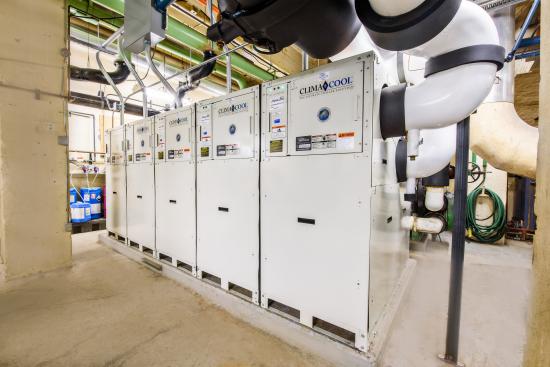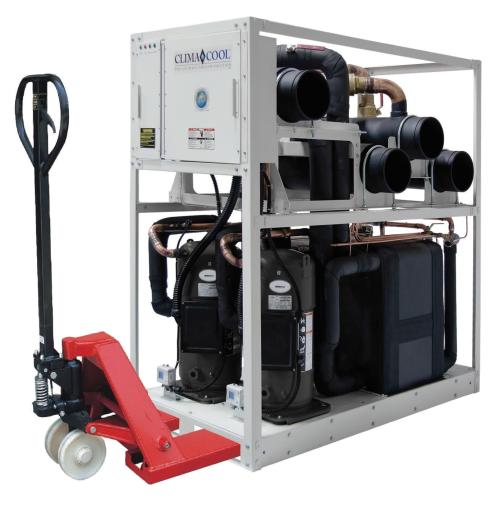06/18/2024
People ask me all the time, “Why are modular chillers becoming popular in so many different applications?” to which I respond, “How much time have you got?”
The genesis of this article, in fact, was when the publisher of this magazine, Roderick Smith, asked me that same question. After I rattled off around 10 different reasons people are compelled to look at modular chillers today, he said, “This really should be an article.” I agreed to write it, and here we are!

Five 80-ton water-cooled modules making up a 400 -ton bank in the basement of an office building.
It's All About the Space
The initial reason the modular concept took hold was a frequent lack of space when it came time to replace a large chiller. Often, these chillers were installed in a confined mechanical room in the basement at the beginning of construction, and the building was then built around it. There was barely enough room to get people to the chiller for maintenance, let alone replacing the chiller itself.
“Chillers last forever, right?” seemed to be the predominant mindset during the 1970s and ‘80s.
Fast forward 20 years and this starts to become a problem. A few innovative companies developed modular chillers to take, for example, a 400-ton single refrigeration compressor chiller (a typical office building might have two of these) and replace each with a bank of five 80-ton modular chillers. Each one could be carried down a stairwell or brought down in a service elevator, then assembled in place. Typically, the large existing chiller would be cut up into smaller pieces for removal during the demolition phase of the replacement project. If the replacement chiller bank was going into the middle of the building or rooftop, immense savings in crane or helicopter lifts were also realized.
At the end of the day, not only did the owner save a good bit on installation, they came away with better redundancy than they had previously. Each module has two fully independent circuits, which means going from one large circuit to 10, providing much better backup flexibility during maintenance periods or service problems. That’s a tenfold increase in redundancy and a great segway into my next topic.

Modular chillers are far easier to move than standard chillers.
Mission Critical Is a Perfect Fit
A mission critical application is anything that’s pivotal to the mission of the business or agency, one essential to providing key business services or surviving. Another good litmus test from a purely economic perspective is any application or process where downtime is more costly than losing cooling. Cooling can never be lost, and so cooling systems seek to maximize redundancy and provide backups in any way they can.
With that in mind, modular chillers are a natural fit. Uses include providing cooling for air traffic control centers, hospital surgery suites, medical devices (MRI and CT scanners, for example), military and aerospace operations, industrial and manufacturing processes, power transmission systems, data centers and critical pharmaceutical laboratories to name a few.
Exact load matching is also an inherent advantage of modular chiller systems. With so many additional steps and circuits, the turndown resolution is exponentially better than with one large chiller. This improves even more with the addition of digital scrolls as well as full variable speed scrolls — either to lead circuits or to all circuits depending on budget available. For many industrial process systems, the fact that they come in small sizes while offering excellent redundancy is attractive. A great example of this is the process used by the growing number of microbreweries popping up around the country. Cooling the wort quickly after the boil and before the fermentation process begins is a critical step. You can thank modular chillers as you sip that cold one!
Planning for the Future
The expandability of modular chillers makes them perfect for owners who like to plan capital expenditures out into the future as far as possible. It’s common for an owner to build room, structural support and pumping for six modules while only initially purchasing two for current needs. Data centers are great examples of this, as future demand can be impossible to predict depending on the sector, but immediate demand is always known.
Availability of Free Cooling
The integration of free cooling into a modular chiller bank is easy and available in two formats. Free cooling is essentially using a colder than set point ambient air temperature to pre-cool or fully cool the load water loop without the use of refrigeration compressors. The most common format is adding a free cooling module or two that includes only water coils and condenser fans. This format is also future-expandable.
If you are tight on real estate for add-on modules, then you may consider the second format. This involves a coil-on-coil setup where you take the existing bank of chillers and add water coils onto the outside of the DX condenser coils. Although this does save space, it incurs an additional and constant air pressure drop across the now wider total coil width that the condenser fans pull air through.
Can I Get a Pump Package With That?
When designing replacement projects, mechanical engineers often look for other areas where system efficiency can be improved. The number one system targeted is pumping. The total dollars to be saved is significant since the pumping system of most commercial buildings runs 24 hours a day. The opportunity to switch from a constant pumping system or primary/secondary system to a variable primary system is usually too lucrative to pass up in terms of energy savings.
Not all systems lend themselves to being switched over easily, but many do. The payback periods can be quick under the right circumstances. Projects that integrate the hydronic system with cooling and heating system controls will only help with overall system reliability. A bank of modular chillers can include a pumping module with controls that seamlessly integrate both systems. In the past, these systems could easily fight each other when decoupled and controlled separately, as was traditional design practice. It also helps when the pumps are in the same room or in close proximity with chillers and boilers, as this minimizes hydronic piping changes needed to fit the new system.

Modular units can be pre-banked at the factory and prewired for a single point connection. This shows five 70-ton modules making up 350 total tons being rigged into place.
Electrification of Heat
Building decarbonization is here to stay. Whenever an owner seeks to reduce their CO2 emissions and eliminate fossil fuels, they look to modular chillers. For years, modular chillers have been sold as heat pumps to either cool or heat using a reversing valve. When you bank several, you can control which modules are in cooling mode and which are in heating mode.
In recent years, advances in controls and valves have allowed modular chillers to achieve simultaneous heating and cooling within a single module. This allows for ultimate flexibility and load matching capabilities, and also provides excellent efficiency. Called heat recovery chiller/heaters, these allow buildings to take waste heat from the cooling process and send it back into the building where it’s needed, rather than rejecting it through a cooling tower or air-cooled condenser. These systems can produce hot water up to 140°F. With the addition of a plate-and-frame heat exchanger, the system can also generate potable hot water.
The environmental advantages of modular chillers go beyond reducing fossil fuel use. They have a reduced low-GWP (global warming potential) total refrigerant charge per ton when compared to larger traditional systems. This has to do with the compact nature of modular chillers and the efficient heat exchangers they use. For owners pursuing LEED Certification, this gives them one full point under the Energy and Environmental Credit section. They are also available with oil-free refrigeration compressor options, which will earn the building owners yet another full LEED point while helping the environment even further.

Three 20-ton air-cooled simultaneous heating and cooling modules conditioning an office building. No boilers or cooling towers were needed.
Keeping Refrigerant Out of the Living Space
With the push for lower GWP refrigerants the field has shifted to A2L refrigerant classes. These are categorized as low toxicity/slightly flammable. The industry is currently switching to these refrigerants due to regulations beginning to be enforced this year in some states, and due to be enforced in all states by January 1, 2025.
If an owner is considering a system that runs refrigerant lines through living spaces – a layout that’s gained momentum in smaller tonnage buildings – they’re now thinking twice about the long-term implications due to refrigerant flammability. Refrigerant monitors will be required in such spaces. If, instead, the owner can run chilled and hot water throughout living spaces with modular chillers, liability comes down and efficiency goes up – albeit with higher upfront cost. More on that below.
Less Water Use Is Best Water Use
Thanks to recent improvements in refrigeration compressor technology and controls, modular chiller banks are now able to seamlessly integrate with other already highly efficient air-side systems. They allow for the removal of open cooling towers or fluid coolers and the water and chemical costs associated with them.
One good example is a water source heat pump system that would typically connect to an outdoor cooling tower or fluid cooler for loop temperature control. These systems are limited to ambient design wet bulb conditions in the project’s particular area. But since water source heat pumps only use that fluid for condensing, the efficiency of the system fluctuates with the outside temperature. If a building replaces its cooling tower with a bank of air-cooled modular chillers, the overall temperature could be brought lower and kept consistent to improve the efficiency of the indoor heat pumps.
The question from this article’s title doesn’t have one simple answer. Although their small size was the reason modular chillers were developed, their role has grown since they excel at a plethora of applications. The initial cost of a modular chiller bank is typically 20 to 30% higher when considering the equipment alone, but the benefits, application flexibility and installation savings typically have owners coming back again and again. The only question left is, “Why not use modular chillers?”
All images courtesy of ClimaCool.
|
About the Author Mark Rogan, PE, CEM, REP, CBCP, GBE, Director of Product Management at ClimaCool, has been in the industry for 30 years. A graduate of the University of Illinois as well as Tulane University, he is a published HVAC System Specialist and an expert in decarbonization strategies and the electrification of heating. |
Mark R. Rogan |
About ClimaCool Corporation
ClimaCool designs and manufactures modular chiller systems configurable to meet any of today’s requirements. Its modular chillers are ideally suited for all commercial/industrial systems including heat recovery and heat pumps, free cooling, geoexchange central plants and variable flow systems. ClimaCool is a division of the Climate Control Group, a NIBE Group member. For more information, visit https://climacoolcorp.com.
To read similar Chiller Technology articles visit https://coolingbestpractices.com/technology/chillers.
Visit our Webinar Archives to listen to expert presentations on Chiller Technology at https://coolingbestpractices.com/magazine/webinars.


